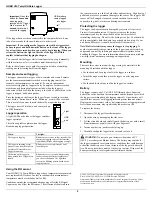
HOBO U10 Temp/RH Data Logger
2
USB
port
Light
If the logger has never been connected to the computer before, it may
take a few seconds for the new hardware to be detected
Important: If you configure the logger to start with a trigger start,
be sure to press and hold down the button on the front of the logger
for at least three seconds when you want to begin logging. When you
release the button, the light on the side of the logger will flash
rapidly to indicate that logging has begun.
You can read out the logger while it continues to log, stop it manually
with the software, or let it record data until the memory is full.
Refer to the software user’s guide for complete details on launching,
reading out, and viewing data from the logger.
Sample and event logging
The logger can record two types of data: samples and events. Samples
are the sensor measurements recorded at each logging interval (for
example, the temperature every minute). Events are independent
occurrences triggered by logger activity. Examples of events recorded
asynchronously during deployment include: when the logger is
connected to the host, when the battery is low, end of a datafile once the
logger is stopped, and button pushes.
Press the button on the front of the logger for one second to record an
event. Both a “button down” and a “button up” event will be recorded.
This is useful if you want to mark the datafile at a particular point.
The logger stores 64K of data, and can record up
to 52,000 samples.
Logger operation
A light (LED) on the side of the logger confirms
logger operation.
The following table explains when the logger
blinks during logger operation.
When: The
light:
The logger is logging
Blinks once every one to four seconds (the
shorter the logging interval, the faster the
light blinks); blinks when logging a sample
The logger is awaiting a start
because it was launched in Start
At Interval, Delayed Start, or
Trigger Start mode
Blinks once every eight seconds until
launch begins
The button on the logger is
being pushed for a Trigger Start
launch
Blinks once every second while pressing
the button and then flashes rapidly once
you release the button. The light then
reverts to a blinking pattern based on the
logging interval
Using the RH sensor
Your HOBO U10 Temp/RH data logger has a temperature-compensated,
user-replaceable RH sensor. In order to take humidity measurements,
temperature must be recorded as well as RH.
Conditions outside the recommended range may offset the RH signal.
Vapors may also affect the RH sensor. The diffusion of chemicals into
the sensor may cause a shift in both offset and sensitivity. High levels of
pollutants may cause permanent damage to the sensor. The logger’s RH
sensor will be damaged if exposed to condensation. It must not be
exposed to fog, mist, or other condensing environments.
Protecting the logger
The logger can be permanently damaged by corrosion if it gets wet.
Protect it from condensation. If it gets wet, remove the battery
immediately and dry the circuit board with a hair dryer before
reinstalling the battery. Do not let the board get too hot. You should be
able to comfortably hold the board in your hand while drying. If your
unit has an RH sensor, it should be replaced if it became wet.
Note! Static electricity may cause the logger to stop logging.
To
avoid electrostatic discharge, transport the logger in an anti-static bag,
and ground yourself by touching an unpainted metal surface before
handling the logger. For more information about electrostatic discharge,
visit http://www.onsetcomp.com/support/support.html.
Mounting
There are three ways to mount the logger using the materials in the
mounting kit included with the logger.
•
Use the hook-and-loop tape to affix the logger to a surface.
•
Attach the magnet and then place the logger on a flat magnetic
surface.
•
Use the double-sided tape to affix the logger to a surface.
Battery
The logger requires one 3-Volt CR-2032 lithium battery. Expected
battery life varies based on the temperature and the frequency at which
the logger is recording data (the logging interval). A new battery will
typically last one year with logging intervals greater than one minute.
Deployments in extremely cold or hot temperatures, or logging intervals
faster than one minute, may significantly reduce battery life.
To replace the battery:
1. Disconnect the logger from the computer.
2. Open the case by unsnapping the side cover.
3. Lift the circuit board and carefully push the battery out with a small
blunt instrument, or pull it out with your fingernail.
4. Insert a new battery, positive side facing up.
5. Carefully realign the logger in the case and re-close it.
WARNING:
Do not cut open, incinerate, heat above 85°C
(185°F), or recharge the lithium battery. The battery may explode if
the logger is exposed to extreme heat or conditions that could damage
or destroy the battery case. Do not dispose of the logger or battery in
fire. Do not expose the contents of the battery to water. Dispose of the
battery according to local regulations for lithium batteries.
© 2005–2012 Onset Computer Corporation. All rights reserved.
Part #: MAN-U10-003, Doc #: 11196-B, Patent # 6,826,664
Onset and HOBO are registered trademarks of Onset Computer Corporation. Other
products and brand names may be trademarks or registered trademarks of their
respective owners.
Important:
Press this
button for
3 seconds
when logger is
launched with “Trigger
Start” or press for
1
second
to record an
event while logging
USB interface
cable plugged
into logger


